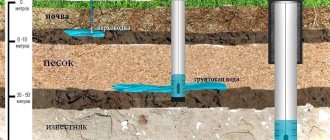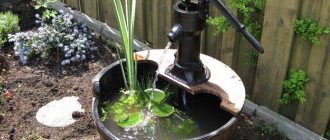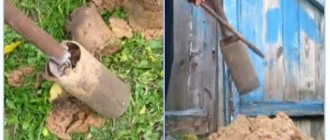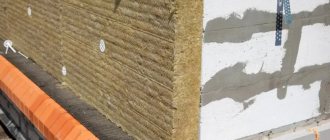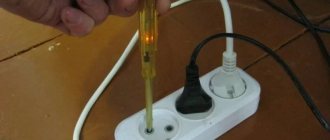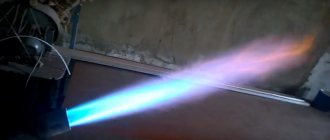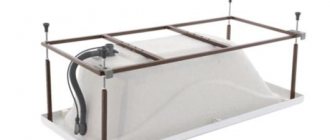An autonomous source of water supply has become an integral attribute of private housing. However, its operation is associated with the need to restore its functionality and periodically clean it of silt and ground deposits. Let's look at what a well bailer is, how it is designed and on what principle it works, what types there are, what the specific application is and what methods for its manufacture exist.
At the bottom of the bailer is equipped with a special valve for collecting soil mass Source ytimg.com
Downhole bailer - what is it, device, principle of operation
A bailer is a special device for cleaning the bottom of a borehole channel from soil and silt deposits. In essence, this is a 1-2-meter section of pipe, the lower part of which has a sharp point - in the form of teeth or a chamfer. A reverse-acting valve mechanism is located inside it. Thanks to this device, dirt, soil, silt and other insoluble particles enter and remain inside until the pipe is lifted to the top and cleaned.
The device operates on the principle of impact interaction. Therefore, the main parameter showing the effectiveness of the bailer is mass. The greater its value, the more productive its use will be, but also the more difficult it is to maintain. The mechanism of its action is carried out according to the following algorithm:
- The pipe section is suspended on a steel cable above the well using a lifting gate on a tripod.
- Next, the bailer is lowered to the bottom of the shaft.
- Then it rises a few meters, and the mount completely relaxes.
- The sharp edge of a steel pipe in a state of free fall crashes into the bottom sediments with force.
To collect bottom sediments, a bailer is inserted into the well and released into free fall Source budshop.com.ua
- As a result of this interaction, the valve mechanism opens and the pipe cavity is filled with dirt.
- The procedure is repeated several more times until the entire internal space is filled with silt.
- After this, the pipe rises to the top and is cleaned.
- If necessary, the operation is repeated until bottom sediments stop flowing into the pipe.
- Finally, the borehole channel is flushed using a pump.
Note! At the stage of attaching the bailer, it is important to correctly select the thickness and degree of rigidity of the cable. It must provide a sufficient margin of safety so that the pipe does not come off, since it will be impossible to remove it from the well after this. On the other hand, it should not be excessively rigid and thick so that it can provide sufficient acceleration to the pipe in free fall.
How to make a limiter and handle
The rational design of a well bailer requires the presence of an element that is convenient for the winch hook to hook onto and is not difficult to grab onto. To set it up, just punch two holes and insert a strong steel wire between them. It is a little more difficult, but more reliable, to weld across reinforcement of the same diameter - it is also good because it will perform a double role: it will prevent soil from spilling out, and will allow you to thoroughly take hold of it. The simplest fastener is the lugs, which are sold ready-made: all that remains is to fuse them with the body.
A coarse metal mesh will work well as a simple but quite effective limiter: to create it you only need to cross-weld thick wire, for example, in a 4x4 format.
Varieties
Based on the above mechanism of action, it turns out that such a bailer can be used not only for cleaning, but also for punching or drilling out a well. Depending on the purpose, the design of the device itself changes.
A bailer is a piece of pipe with a pointed working edge and an internal valve Source saucyintruder.org
There are 3 main modifications of it, differing primarily in the type of valve:
- Petalaceae.
The device is equipped with this version of the valve mechanism, which is based on a movable metal flat petal. The element is fixed in the lower part inside the pipe on a pulley, repeats the geometric shape of the cavity section and works according to the following principle:
- When the device is immersed to the bottom of the well and comes into contact with the ground, the petal rotates.
- A passage opens and deposits begin to fill the cavity.
- When the pipe is lifted, the dirt filling the cavity begins to put pressure on the back side of the plate, it rotates back and the valve closes.
- On the surface, the device is turned over and emptied of dirt.
- The procedure is repeated until the bottom sediments are completely cleared.
This option is simple and inexpensive to manufacture. Can be used for both cleaning and drilling. The only drawback is the short service life. It is cured by the fact that part of the pipe with the valve is made removable with a thread, and if it breaks, it is simply screwed off and a new one is installed in its place.
After lifting from the well, the bailer must be cleaned each time Source ytimg.com
See also: Catalog of companies that specialize in engineering systems (heating, water supply, sewerage and others) and related work
- Ball.
In this modification, the well cleaning bailer is locked with a ball. Operation is ensured by the following feature of the device and operating principle of the valve:
- From below, in the area of the working part, the movement of the ball inside the cavity is limited by an inserted and secured ring or funnel.
- In the normal state, the ball lies on the ring and closes the passage.
- When immersed, bottom sediments move the ball upward and begin to fill the cavity.
- To prevent the ball from coming out through the upper cut of the pipe, a limiting pin is installed inside - for example a bolt.
- When the pipe rises upward, the masses of dirt in the pipe put pressure on the ball, it lowers, rests against the ring and the exit closes.
- The raised bailer is cleaned and reused until the channel is completely clean.
The advantage of this option is high efficiency, load resistance and durability. However, it is somewhat more difficult to manufacture than the previous version. It can be used both for cleaning an old well and for creating a new well.
A special washer is installed into the working edge of the pipe for the operation of the ball valve Source ytimg.com
- For drilling.
In order to drill a vertical channel in the ground, you will need a bailer slightly modified with the following working components:
- The cutting part that is in direct contact with the ground should have the shape of pointed teeth that are slightly spread out to the sides.
- Another piece of pipe is inserted into the cavity, reaching the middle of the device and fixedly attached to it and equipped with a thread.
- Subsequently, as the drilling depth increases, the length of the structure increases with additional segments through a threaded connection.
To make the device rotate more easily and loosen the soil, the pipes are equipped with through holes along the entire length at a short distance from each other. Rotation is carried out through a piece of reinforcement inserted into them. Borehole channels of shallow depth are created by punching - by analogy with the cleaning technique; deeper ones, and also in the case of passing through dense rocks, are drilled by rotation.
Drilling with a bailer requires special training and the use of additional equipment Source ytimg.com
On a note! The use of bailers for drilling the soil is justified only for borehole channels of small depth - no more than 10 meters. Since the method requires significant physical effort, a lot of time and is characterized by low productivity. Otherwise, you will have to mechanize the installation, and this will lead to greater costs than using specialized drilling equipment, and the available depth will only double.
Maintenance, operating tips
The following signs will indicate that it is time to seal:
- For some reason the well was not used for several months.
- The pump is missing air.
- Water contains impurities.
- After several minutes of running the tap, the water stream visually becomes thinner.
When starting to clean a working well, and this can happen every 3-4 months, be sure to make a visual assessment of its internal surface. The work may be complicated or made impossible by significant deformation of the shaft walls, loss of their integrity, or severe siltation.
Then the condition of the working equipment is checked: wear and strength of the cable, free (without jamming) operation of movable joints, reliability of fasteners.
A tripod installed above the well with a block onto which the cable is placed will help make the work easier. The result is strictly vertical operation of the device, easy lifting through the block, especially with an additional winch used. To ensure that a device torn off during operation does not create a serious problem and does not stop the process for an indefinite time, it is advisable to weld a pair of hooks to the pipe. They will come in handy for quickly removing it from the well in case of force majeure.
All work with the device ends with thorough cleaning of the internal cavity from soil. The square window at the top of the pipe will help make this faster and easier. For clayey or dense viscous soils, such a window is made along the length of the entire pipe. It is advisable to store a clean and dried bailer in a dry utility room until the next use.
On moist, sandy, loose, soft soil, you can independently drill a well or make a diagnostic puncture using a device. If the soil structure does not meet the specified characteristics, the work is entrusted to specialists using professional equipment.
Specifics of drilling in various soils
Drilling water wells with a bailer is not too different from the cleaning technology, with the exception of sandy soils and so-called quicksand - here it is necessary to carry out the procedure inside the casing, for example, of the corresponding diameter of a PVC pipe. In denser rocks this need does not arise.
To drill in unstable soil, it is necessary to use PVC casing pipes Source burovik.ru
In general, when creating a borehole channel in each type of soil there is its own specificity:
- Quicksand . The use of casing is mandatory, since without it the walls of the created channel will quickly collapse. To do this, a shallow pit is created into which the casing pipe is immediately placed. Then a bailer is inserted into it and cyclic deepening and cleaning of soil is performed. As you move deeper, the casing is continuously built up using segments.
- Dry sand . The procedure is carried out in a similar way, but with the exception that water is constantly supplied into the created channel to make it easier and faster to extract the soil mass.
Along the way of laying a well, various aquifers and soil types may be encountered Source buroplast.ru
- Clay . The operation is performed without casing. Soft rocks can be drilled with one pipe - without a valve mechanism. The soil will simply accumulate in the pipe and then be removed as it is lifted. In clayey rocks of high viscosity, it becomes necessary to preliminary break up the layer with a chisel, and then remove the already loosened mass with a bailer. If the clay is dry, it can be slightly moistened until the drill reaches the aquifer.
- Crushed stone and gravel . When layers of crushed stone and gravel appear along the excavation path, the casing pipe is slightly raised to avoid compaction of the soil mass, and the speed and pressure on the drilling mechanism is lightened. They also slightly increase the water supply. If necessary, a chisel is first used, after which the crushed mass is taken out with a bailer.
Recommendation! To avoid significant siltation and shutdown of the well, it is necessary to clean its channel every 1-2 years. The frequency of the procedure directly depends on the operating mode and the frequency of water intake. Therefore, every responsible owner of an autonomous water source will need a reliable, high-quality bailer.
Plastic bottle valve
A suitable plate can be made using a plastic container.
- To do this, you need to cut an ellipse from its wall with sides of, for example, 90 and 70 mm. The smaller number must be equal to the internal diameter of the projectile.
- Then insert two wire rings - 6-8 mm - into the middle part of the oval.
- Next, drill a couple of parallel holes in the pipe.
- Well, then slightly bend the petal, carefully push it inside the body and secure it with a bolt with the appropriate double radius, passing it through the seats.
Manufacturing methods
There are the following 2 main ways to make a bailer for cleaning or drilling a well - these are:
- Petal.
The manufacturing procedure is reduced to the following algorithm:
- A pipe section of 10-15 cm is selected - with such a diameter that it fits into the bailer as tightly as possible.
- A circle is cut from sheet metal to exactly match the outer diameter of the insert.
- Next, the element is fixed to the insert using spring loops.
- Then the pipe section is carefully inserted into the bailer and secured through the pre-drilled holes with a swamp.
- The position of the insert is such that the valve opens only inward - to take in the soil mass.
If you don't have a welding machine
Let's look at how to make a bailer with your own hands and ensure reliable quality of connections when it is not possible to solder the elements together. To do this you should:
- take a suitable pipe;
- drill 2 holes in its upper part, thread a steel wire and fix it;
- make a petal valve from a plastic bottle (we will explain how below separately) and secure it to the shoe with a 6-8 mm bolt of the appropriate length.
Video description
Video instructions for making a bailer:
A wire loop, pin or bolt is attached to the opposite part of the bailer to secure the cable.
- Ball.
To make a bailer of this modification, you will need:
- Select a metal ball of suitable diameter - for example, if a 90 mm pipe is used, then it should be about 55-65 mm.
- The lower edge of the bailer is sharpened - like a chamfer or in the form of sharp teeth.
- Next, a washer of a suitable size is inserted into the lower part to fit under the ball. In its normal state, the ball should tightly cover its hole.
- At a height of 3-4 ball diameters from the washer, a limiter, for example a bolt, crashes into the pipe wall.
- To attach the cable, a through hole is drilled in the upper part of the pipe.
Note! Before starting work on cleaning the borehole channel, you need to make sure that there are no obvious defects on its walls. Otherwise, the bailer may jam when lowering.
Gelonding scheme with pump
In case of large deposits of silt or sanding of an aquifer mine, they resort to gelling technology with a pump. To do this, the upper part of the body is welded and an outlet is mounted to it.
After installing the fitting with the hose, a pump is connected, designed for pumping liquids with a high content of mechanical impurities. This method allows you to pump out bottom sediments without constantly cleaning the instrument. The work of the bailer itself boils down to the need to loosen the soil and move it into the chamber.
Briefly about the main thing
The bailer is a piece of steel pipe with a pointed lower edge and a valve mechanism inside. When it is lowered freely into the well, the valve opens and releases soil masses inside, and then, when lifted, it closes and prevents their exit. This method is used to clean or drill a borehole channel.
Devices are divided into 3 main types:
- Ball.
- Petalaceae.
- Specially designed for drilling.
Each of them has its own pros, cons and operating features. Drilling with their help has its own specifics depending on the type of soil. You can make a bailer for cleaning a well yourself if you have experience in processing and assembling metal structures, but it is better to entrust this task to a specialist or buy a ready-made factory model.
How to make a cutting edge
A shoe with a pointed edge cuts better into sticky and frozen soil, which greatly simplifies the work. And there are two options for its suitable form:
- Flat - you need to sand it on the outside and grind it inward on the other side, making it look like a cone. It is great if the steel is also hardened - this prevents breakage or dulling.
- Toothed - a “herringbone” is made, and each of its protrusions is processed in the same way as the entire edge in the previous case, only separately. To protect the contact surfaces, you can then apply paint or primer.
Kinds
By type of valves there can be:
- Ball.
- Flat folding.
Ball type is a very convenient and common option.
The ball moves freely inside the pipe when it is squeezed out by silt, but under the influence of gravity, it clogs the hole again. More suitable for small diameter pipes.
If there is simply no suitable ball, a flat part is made from any available materials (corresponding to the inner diameter of the pipe), which is hinged to one of the inner edges. Water resistance opens the flat valve. The hinges must be corrosion resistant. In addition, to ensure that the valve closes well, you can make a bumper pin inside the pipe. It will limit the plate opening to 70-80°
The ball model must have an internal limiter. If this is not done, the ball will “flush” too high and most of the collected sludge will flow back out.
Water purification from iron and lime
Purifying iron from well water is a fairly common problem. Because most often its content exceeds the permissible sanitary standard of 0.3 mg/l. In fact, this does not pose a threat to humans, but it has a negative effect on household appliances.
There are several methods for purifying iron from a well:
- aeration;
- reverse osmosis;
- filters for cleaning.
Aeration
The aeration system for purifying water from a well is based on enriching the water with oxygen, due to which the iron contained in the water oxidizes and precipitates. There are two types:
- pressure - in this case an aeration column is used. Water enters it and air is pumped into it by a compressor. Typically, this cleaning method is used when the iron content from the well is more than 30 mg/l;
- non-pressure - based on the principle of a sump; a compressor is also used to pump air.
Non-pressure water purification system from iron:
- a large capacity is required to settle the water, usually more than 500 liters, an aquarium compressor can be used, a float switch for the pump;
- it is necessary to provide for the possibility of draining water at the top of the tank, for example, if the float switch does not work and the pumping station does not stop in time;
- compressor divider, installed approximately in the center of the container;
- It is also necessary to implement a system for cleaning the container from sediment.
Schematic diagram of iron removal
The aeration system for purifying water from iron solves another issue - removing hydrogen sulfide from the liquid. Due to contact with air, sulfur oxidizes and settles on the filters.
Reverse osmosis
Purifying water for the home using reverse osmosis is based on the use of membranes that are able to retain the smallest impurities. Those. Such systems have a very high degree of purification.
Peculiarities:
- high water consumption - about a third of the water enters the water supply system, the rest is spent on cleaning the membrane system;
- The output is distilled water - it needs to be mineralized;
- such water purification systems from wells are expensive to maintain;
- cannot be used if the iron content is more than 20 mg/l.
Reverse osmosis
When using this method, consumption points are most often divided:
- Reverse osmosis is used for drinking water;
- For other needs, a different filtration system is used.
This allows you to significantly save on system maintenance.
Thus, the easiest way to remove iron from water from a well is to use a gravity aeration system.
Lime removal
Unfortunately, getting rid of lime in water is not easy. To date, there are no simple and accessible ways to solve this issue.
Cleaning water from a well from lime is done using special catalytic filters. But, you first need to do laboratory tests to determine the content of impurities.
Based on analyzes and load calculations, a suitable filter for lime water and its operating mode are determined.
Today there are enough ways to clean a well with your own hands. When the bottom becomes naturally contaminated, mechanical methods are used
It is important to remember that the main cause of severe pollution is infrequent prevention. If the water is saturated with iron, lime or other trace elements, you cannot do without a good filtration system
Useful recommendations from experts
If the depth of the water exceeds the length of the drill, then it can be extended by joining another pipe on top. They can be joined using a threaded coupling or a welding connection. When using small diameter pipes, bolts or cotter pins can be used. However, such a connection is not very reliable, and with a large rotational force, the bolt can be sheared and the rods will become disconnected. Getting the drill remaining in the well can be very problematic.
Before starting to design the device, it is recommended to draw up a drawing of the drill for the well. This will give you the opportunity to have a visual example of what should come out in the end. Attempting to create a drilling mechanism using the “scientific poke” method is more exciting for some home craftsmen, but takes too much time and effort.
An easier manual version of drilling a well is using a bailer bit. Raising and releasing the impact tool requires less force than rotating a buried drill. In addition, even one person can drill using the percussion method. True, this method is very long, and the work can drag on for several days.
If you cannot lift the auger drill out of the well yourself, you can make the task easier by building a device for the lever. For example, placing a barrel next to it and throwing a block over it. Tie one edge of the block to the drill, and apply physical force to the other edge.
Helpful2Not Helpful
Principle of operation
A bailer is used for drilling wells in loose or loose rock (sand, loam). The device is used to increase the volume of water and remove sand and silt.
The work is carried out according to one principle - the device is thrown down.
Accelerating under the influence of gravity, the projectile hits the rock, which, penetrating inside, opens the valve.
Having passed inside, the soil releases the valve, and it closes, preventing the rock from spilling back out.
With one blow, 200-300 grams of rock are collected, so the bailer is raised up 30-50 centimeters and thrown again.
These steps are repeated until the device is completely filled with soil. The filled shell is lifted to the surface, turned over and the rock is removed.
IMPORTANT! This method is called shock-rope. To construct and clean the well, this operation is repeated many times.
Clearance may take 3 to 8 days. It will take several weeks to drill a well in this way (read how to install water supply in a private house in this article)
To construct and clean the well, this operation is repeated many times. Clearance may take 3 to 8 days. It will take several weeks to drill a well in this way (read how to install water supply in a private house in this article).
To facilitate the work, install a tripod with a block system. This setup makes the job much easier.
If a bailer does not pick up soil well, then it is usually too light. The projectile is weighted by filling the top of the pipe with concrete or by attaching a weight to the bottom.
Creation details
What is needed to equip a bailer
In order to make a bailer, you must have:
1.pipe of suitable volume.
2.valve device.
3.welding equipment.
4.cable made of metal material.
5.strong wire.
6.cuts of metal.
To manufacture the device, it is necessary to select a pipe of the required cross-section. When choosing a suitable edge, they are guided by the internal section of the casing. There should be a gap of two centimeters between the walls of the wellbore and the outside of the bailer. To calculate the cross-section of the rolled pipe for the bailer, subtract forty millimeters from the internal cross-section of the casing pipe. The resulting figure is the required diameter of the bailer.
Attention! The pipe cut should be of sufficient length with thick walls. Its weight must effectively remove dirt from the bottom, while it must remain light in order to remove the device from the well for cleaning many times.
The distance from the walls of the shaft and bailer may differ from the required value, but cannot exceed the permissible limits. The efficiency of the device will decrease with a very large gap, and with a small gap the bailer can break the well. If the wellbore is skewed, the bailer may get stuck if its size exceeds the permissible size. When pulling out, it is possible to seriously damage the walls. The bailer length parameters should also be optimal. A short bailer will often touch the walls when raised or lowered.
A very long bailer can be difficult to lift with mud deposits. The optimal length is eighty centimeters, the minimum value can be sixty centimeters, the maximum is one hundred and fifty. If the bailer is used for drilling work, then you will need a pipe that is much heavier and longer in size. The weight of the device is affected by the thickness of the pipe walls. If they are thick, then the weight is greater, which means the efficiency of the equipment is higher. The average thickness of a bailer is considered to be up to four millimeters, but the product can have a wall size of ten millimeters.
When determining the dimensions of the pipe for the device, two important conditions must be adhered to:
1.Provide high level of penetrating force to remove contaminants effectively.
2. the weight of the filled device must be accessible to lift the equipment with your own hands or with a winch.
Types of valves for the device
The device is based on a valve device. The element is made in the form of petals or a ball. With the help of a valve, dirt penetrates into the bailer without falling out of it during lifting. If you ensure a tight fit of the valve, the device can collect dirt and water from the bottom at the same time, improving the quality of the cleaning process.
...in the shape of petals
This valve does not have a high durability rating, but the device is easy to make with your own hands. The valve is made from an oval-shaped plate using a springy metal or polymer material. The device is mounted in the center of the pipe. The water pressure acts on the edges of the valve, they open, and silt deposits penetrate inside. To ensure that the valve tightly touches the walls of the bailer, seals made of leather or rubber are used.
Reference! The flap valve works like a door. When it hits the ground, the valve presses on the door and it opens. When lifting the bailer upward, the weight of the load presses on the valve, which closes the “door”.
Valve petals wear out quickly when opened and closed frequently. A type of valve with petals is a spring gate valve. The valve operates using a strong spring. It is easy to build a bailer with such a valve yourself. The design is used during well cleaning activities, and it can also be used to drill new sources.
…spherical
This type of valve has the shape of a funnel; its hole is closed using a ball selected to size. The most important thing when assembling a bailer that has a valve with a ball is to find a ball of the required volume. It must be large because the valve has a large hole to draw in water containing dirt. At the same time, the ball must be of sufficient weight so that when the bailer moves, it quickly closes and opens the valve.
Options where you can get the ball:
1.find the part in the old bearing.
2.make a ball to order from a turner.
3.make a ball with your own hands using available materials.
Process
To make a ball with your own hands, you will need a ball made of rubber or plastic. You need to buy lead shot at a hunting store. You should also purchase moisture-resistant glue, for example, epoxy. The ball must be cut in half and filled with a mixture of glue and shot. When they dry, they are glued together and sanded. The ball can be used.
If there is no shot, then you can use balls from bearings, or make them from lead. The ball must have a size that is up to 75 percent of the cross-section of the well casing pipe. In the main part of the valve, which has the shape of a thick washer of metal material, a place for the ball is prepared by cutting a hole in the shape of a funnel. The first step is to find the ball, then prepare a washer for it. The valve must have a large hole to catch a lot of dirt at one time. If the goal cannot be achieved, then the hole should be bored as much as possible, as the volume of the ball allows.
Attention! If the ball is made to order, then it is advisable to immediately order a suitable saddle for it.
